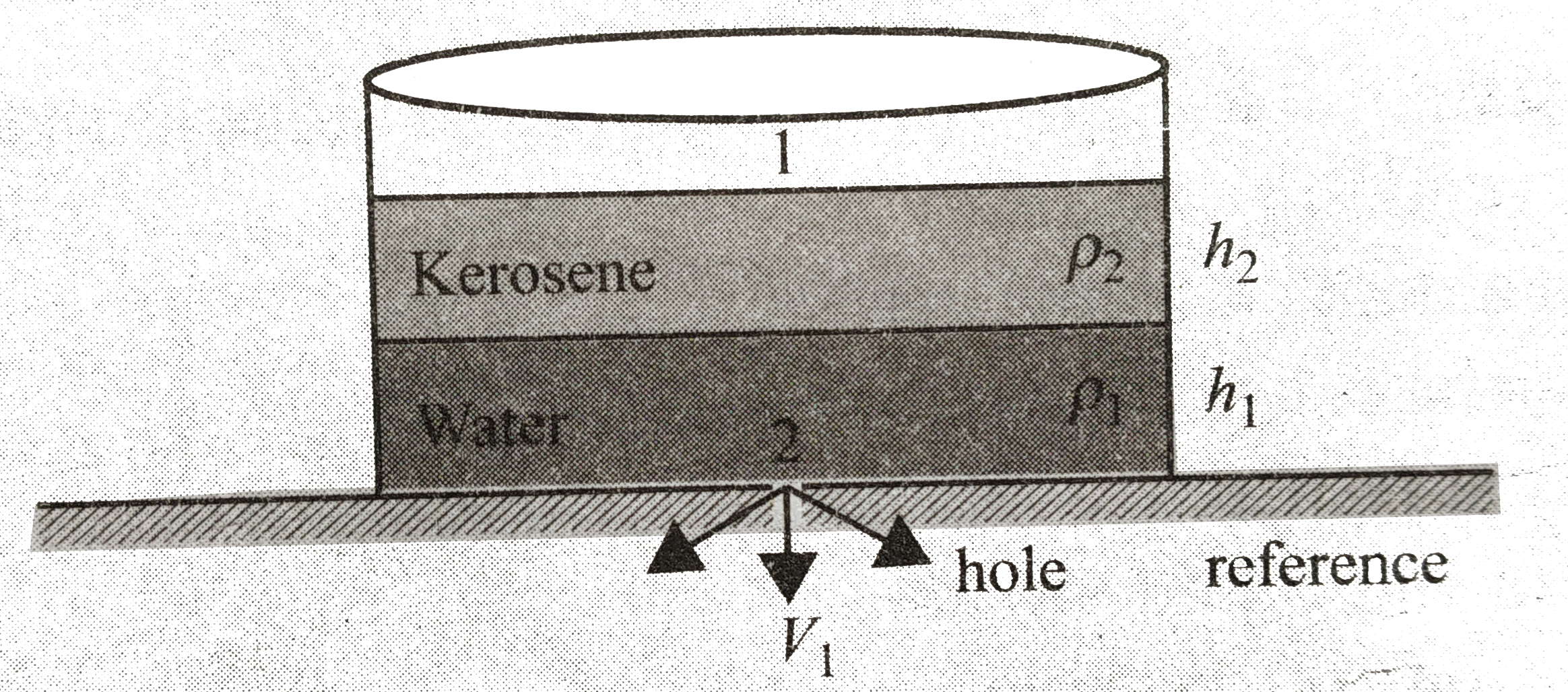There is a small hole at the bottom of tank filled with water. If total pressure at the bottom is 3atm(1atm=105Nm−2), then find the velocity of water flowing from hole.
The correct Answer is:B
To find the velocity of water flowing from a hole at the bottom of a tank filled with water, we can use the principle of fluid dynamics, specifically Torricelli's theorem. The velocity of the fluid can be derived from the pressure difference.
1. Identify the Given Data:
- Total pressure at the bottom of the tank, P=3atm
- 1 atm = 105N/m2
- Density of water, ρ=103kg/m3
2. Convert Pressure to SI Units:
- Total pressure at the bottom in SI units:
P=3atm=3×105N/m2
3. Calculate the Pressure at the Surface:
- The pressure at the surface of the water is 1 atm, which is:
Psurface=1atm=1×105N/m2
4. Determine the Change in Pressure:
- The change in pressure (ΔP) that causes the water to flow out of the hole is given by:
ΔP=P−Psurface=(3×105)−(1×105)=2×105N/m2
5. Use the Bernoulli's Equation to Find Velocity:
- According to Bernoulli's principle, the velocity (V) of the fluid can be calculated using the formula:
V=√2ΔPρ
6. Substitute the Values:
V=√2×(2×105)103=√4×105103=√4×102=√400=20m/s
7. Conclusion:
- The velocity of water flowing from the hole at the bottom of the tank is 20m/s.
- Total pressure at the bottom of the tank, P=3atm
- 1 atm = 105N/m2
- Density of water, ρ=103kg/m3
- Total pressure at the bottom in SI units:
P=3atm=3×105N/m2
- The pressure at the surface of the water is 1 atm, which is:
Psurface=1atm=1×105N/m2
- The change in pressure (ΔP) that causes the water to flow out of the hole is given by:
ΔP=P−Psurface=(3×105)−(1×105)=2×105N/m2
- According to Bernoulli's principle, the velocity (V) of the fluid can be calculated using the formula:
V=√2ΔPρ
V=√2×(2×105)103=√4×105103=√4×102=√400=20m/s
- The velocity of water flowing from the hole at the bottom of the tank is 20m/s.
Topper's Solved these Questions
- FLUID MECHANICSBOOK - DC PANDEY ENGLISHCHAPTER - FLUID MECHANICSEXERCISE - Exercise16.6
4 Videos
- FLUID MECHANICSBOOK - DC PANDEY ENGLISHCHAPTER - FLUID MECHANICSEXERCISE - Exercise16.7
4 Videos
- FLUID MECHANICSBOOK - DC PANDEY ENGLISHCHAPTER - FLUID MECHANICSEXERCISE - Exercise16.4
4 Videos
- EXPERIMENTSBOOK - DC PANDEY ENGLISHCHAPTER - EXPERIMENTSEXERCISE - Subjective
15 Videos
- GENERAL PHYSICSBOOK - DC PANDEY ENGLISHCHAPTER - GENERAL PHYSICSEXERCISE - INTEGER_TYPE
2 Videos
Similar Questions
A hole is made at the bottom of the tank filled with water (density =1000kgm−3). If the total pressure at the bottom of the tank is three atmospheres (1 atmosphere =105Nm−2), then the velocity of efflux is nearest to
View SolutionThere is a small hole near the botton of an open tank filled with liquid. The speed of the water ejected does not depend on
View SolutionA wide vessel with a small hole in the bottom is filled with water and kerosene. Find the velocity of water flow if the thickness of water layer is h1=30cm and that of kerosene is h2=20cm brgt

View SolutionA wide vessel with small hole in the bottom is filled with water and kerosence, Neglecting viscosity, the velocity of water flow v, if the thickness of water laer is H1 and that of kerosene layer is H2 is (density of water p1/ and that of kerosene is p2/.
View SolutionThe pressure at the bottom of a tank of water is 2P, where P is the atmospheric pressure.If the water is drawn out till the level of water is lowered by one half of initial,the pressure at the bottom of the tank will now be
View SolutionThe flat bottom of cylinder tank is silvered and water (μ=43) is filled in the tank upto a height h. A small bird is hovering at a height 3h from the bottom of the tank. When a small hole is opened near the bottom of the tank, the water level falls at the rate of 1 cm/s. The bird will perceive that his velocity of image is 1/x cm/sec (in downward directions) where x is
View SolutionThe pressure at the bottom of an open tank of water is 3p where p is the atmospheric pressure. If the water is drawn out till the level of water remains one fifth, the pressure at the bottom of the tank will now be
View SolutionA tank of height H and base area A is half filled with water and there is a small orifice at the bottom and there is a heavy solid cylinder having base area A3 and height of the cylinder is same as that of the tak. The water is flowing out of the orifice. Here cylinder is put into the tank to increase the speed of water flowing out.
After long time, when the height of water inside the tank again becomes equal to H2, the solid cylinder is taken out. then the velocity of liquid flowing out of the orifice (just after removing the cylinder) will be
View SolutionWater is filled in a container upto height 3m. A small hole of area 'a' is punched in the wall of the container at a height 52.5 cm from the bottom. The cross sectional area of the container is A. If a/A=0.1 then v2 is (where v is the velocity of water coming out of the hole)
View SolutionThere is a hole at the bottom of a large open vessel. If water is filled upto a height h, it flows out in time t. if water is filled to a height 4h, it will flow out in time
View Solution
